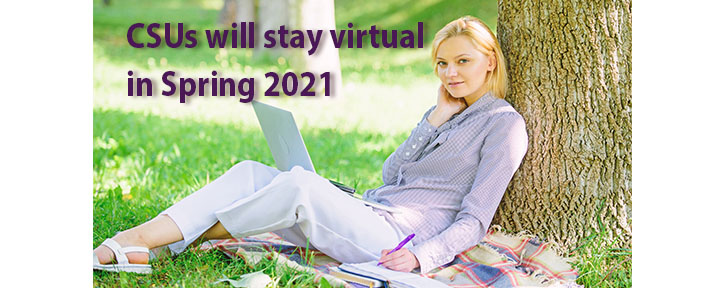
The California State University (CSU) system has announced that their all of their campuses will continue to have remote learning for spring semester 2021. I’m glad to hear that they have made this decision and have communicated their plans with their students, faculty, and staff so everyone can make plans accordingly. It’s the respectful and responsible thing to do. I wish all campuses would do the same. The sooner we stop the spread of the coronavirus, the sooner we can get back to school and work! It’s really that simple.

The California State University (CSU) system has announced that their all of their campuses will continue to have remote learning for spring semester 2021. I’m glad to hear that they have made this decision and have communicated their plans with their students, faculty, and staff so everyone can make plans accordingly. It’s the respectful and responsible thing to do. I wish all campuses would do the same. The sooner we stop the spread of the coronavirus, the sooner we can get back to school and work! It’s really that simple.

This virus is alive and spreading. Thinking that it’s just going to go away in different regions while the rest of the states and countries continue to see new outbreaks is naïve. It surprises me that intelligent people think that they can gather in groups smaller than 10 and that they’re safe. Seriously? Just meeting with ONE PERSON is not safe today. You don’t know who that person has been with during the last 2 weeks (girlfriends, coworkers, teachers), what surfaces they have touched (grocery stores, gas stations, door knobs), if they are asymptomatic, or if they may have a false-negative coronavirus test result. Take-away message: YOU DON’T KNOW WHERE THEY’VE BEEN!
The University of Arizona just analyzed student dorm sewage on campus and found one dorm tested positive. They tested the 311 students who lived and worked in the dorm, and found 2 asymptomatic students. These students were quarantined. Had the university not stepped up their proactive analysis of student sewage, the students could have spread the virus all over campus.
Colleges are opening up across the United States with great intentions of keeping students safe. They expect students to follow an honor code with rules about the numbers of people they party with and the 6-foot distance to keep between themselves. I wrote a blog about why college students’ prefrontal cortexes aren’t fully developed until age 25 so they don’t have the reasoning skills they need to make smart decisions. When college students engage with roommates, classmates, professors, and staff on campus, and then they visit friends in the local community, travel home to see family for holidays, and zigzag their way through public transportation and on airlines, they may become the reason that we see a huge rise in COVID cases and death this fall and winter.
The “rules” that everyone loosely considers when they’re out in public are just general rules. The 6-foot rule is for people who are not breathing hard. In other words, they’re not walking or running, they’re not exercising, and they’re not laughing or talking loudly. My daughter Nicole (an ER doc) says that the safe distance is really 10 feet, not 6 feet.
I find it ridiculous that it’s okay to gather with less than 50, 25, or even 10 people. Say one of those people is asymptomatic or has been tested but had a false negative reading, that person could most certainly infect the other 49, 24, or 9 people in that “safe group.” As long as we are circulating with anybody outside of our households, we are part of the problem. We are all spreading the coronavirus if we have contact with other people. Period.
Hindsight is 20/20, and if I would have known what I know today and had the influence to do this, I would have shut down the entire world for 2-4 weeks. If everyone would have stayed home and only hospitals, law enforcement/first responders, and absolutely essential businesses stayed open (with daily testing and quarantining), we could have stopped the coronavirus from spreading. We would all be back to work and school today, and we would have bounced back economically – we now know we can survive a 2-4 week shut down.
This has been an enlightening year for me. As the eternal optimist, I thought that we would have the coronavirus under control in a few weeks, or months. But what I’ve learned is that when we don’t understand a threat like a pandemic, we get scared. This fear drives our next steps that make us think we’re invisible; we won’t get the coronavirus so we’ll forge forward! – or – we think we’re going to die; we need to protect ourselves by staying away from everyone. Then, we look for leaders or information that support our beliefs. By hearing what we want to hear, we’re not making sound decisions about how to stop the spread of COVID-19. So today, decisions are being made for political and financial reasons, not for humanitarian reasons.
SOURCE
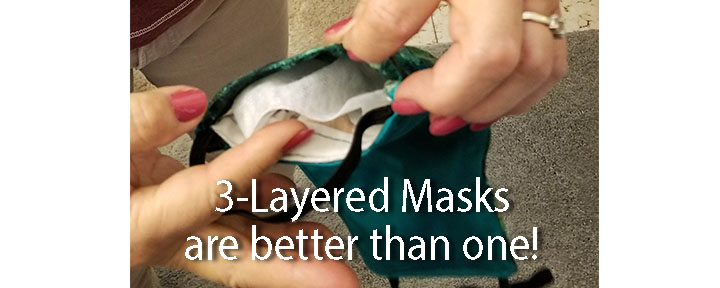
If you’re going to wear a cloth mask, Australian researchers say that masks with two or three layers better protect against the spread of the coronavirus than single-layered masks. Phew! Michele Roush and I sewed hundreds of masks for ER healthcare workers and firefighters. Our three-layered masks have a pocket for a filter to add even more protection.
Here is the pattern we used.
Here is a video I made to show you how to sew them.
I posted this blog: Make masks for healthcare workers back on April 3, 2020. They actually need N95 masks while working with COVID-19 patients; these three-layered cloth masks are for the public. Mask up to stop the spread of the coronavirus!
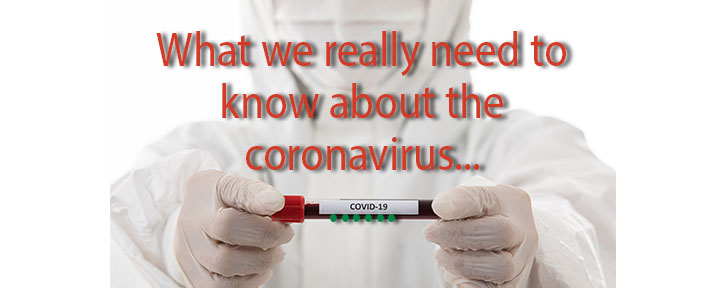
Let’s get our heads out of the sand and start making important decisions about how we must conduct our lives in the midst of a pandemic that is NOT going away anytime soon, or ever. Yup, without a unified plan to lockdown – yes – keep everyone home until the coronavirus is dead, this will go on for years. I just had a heart-to-heart conversation with Nicole, my daughter who is an ER doc, about the coronavirus. This is what she believes we’re facing:
The coronavirus is very contagious and it can adapt. Additionally, the science behind designing vaccines is very complex. First you find a part of the virus to mimic in the targeted vaccine. That way when your body comes into contact with that part of the virus, your body already has antibodies to fight it. Next you need to make sure that the antibodies that your body makes to the vaccine will work to help your body fight it when you come into contact with the actual virus. You don’t want those antibodies to actually make your response even worse such that you get even sicker (this happened with dengue vaccine attempts).
We can’t blindly wait for a miracle vaccine to solve our coronavirus problems. To make a vaccine safely, and confirm that it will not cause this increased response that makes it even more lethal via antibody-dependent enhancement, we will need to perform phased clinical trials on real people (likely on 100,000s of healthcare workers who volunteer for this). Most vaccines take years to decades to prove efficacy and safety before they are ready to distribute, especially to millions of people at once. This will take years to roll-out safely/responsibly.
Nicole spends most of her free time reading scientific journals to follow developments in treatments, vaccines, and epidemiology. Your doctors aren’t getting their covid-19 updates from TV news, politicians or social media.
She is now worried about the two possible trajectories for this pandemic:
1. Everyone begins to go back to work and school/college; gather with family and friends at home, restaurants, and other public venues; and travel across city, state, and national borders. The coronavirus continues to spread and COVID-19 kills millions of people around the world. Anyone who is going to get coronavirus will get it and those who are susceptible will recover, suffer long-term lung and blood vessel damage, or die. After these millions of people are infected, whoever is left standing will either be immune themselves or protected by herd immunity.
2. We collectively, in unison, change our lifestyles to prevent spread of the virus. Universal mask wearing, social distancing, hand hygiene, stay completely isolated at home when you have any hint of the sniffles or body aches, etc. This would slow the transmission of the virus such that the healthcare system is not overwhelmed (like NYC in the beginning and like Texas and Southern California are trending towards now), and the people who do get sick will be treated with all of the techniques that are being studied and developed with reliable and reproducible scientific clinical trials (which takes time).
Individual cities or regions or states or countries cannot make decisions about when to lift shelter-in-place orders. This pandemic is global and affects the entire world population. As a planet, we need to protect ourselves and protect others from spreading this deadly virus. That means that until it is contained everywhere, we all need to stay home to minimize nonessential contact, consistently wear masks, and maintain 6-10 feet distance away from everyone.
Stop thinking that your life will go back to the way it was BC (before coronavirus). We will always need to protect ourselves and others from spreading the virus. A new swine flu with pandemic-level characteristics has just been discovered in China this month. There are more pandemics on the horizon, even when this one slows down. Washing hands (or using hand sanitizers when out in public), and wearing masks can become our new normal. Dining outdoors when socializing and staying 6-10 feet apart will be how we meet with and gather with friends and family. Shaking hands will be replaced with nods or fist bumps.
Want to see how I’ve created a place and protocol for social gatherings that respect our need to protect one another? Check out my blog:
Or take a look at my guidelines for safe gatherings.
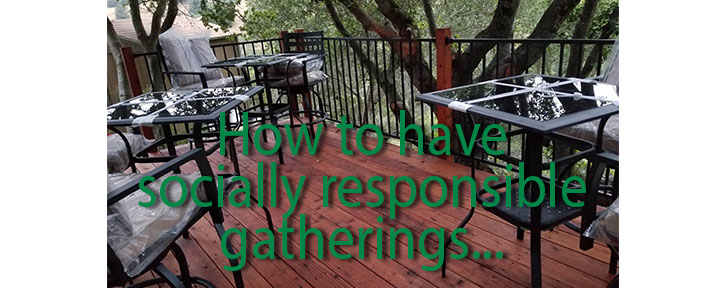
Our house has always been the party house. We have hosted all holiday parties, birthday parties, meetings – any reason to get together. I love to cook and entertain. So I’ve had to rethink how to socialize with family and friends in a safe and responsible way. At first, it seemed cumbersome, but as months pass, I realized that I can do this. Here are my tips on Socially Responsible Gatherings.
Where:
I just built a redwood deck and 3 bistro tables with 2 chairs per table. I also remodeled my kitchen deck with 2 bistro tables with 2 chairs per table. The tables are set 6 feet apart. Being outdoors is much safer than indoors.
When:
Rather than dinners with late-night activities, I’m planning afternoon gatherings when we can be outside.
Who:
Instead of having 25-50 people, I am inviting just one or two couples. While it’s fun to have huge bashes, it’s also fun to talk to a few friends and really catch up on our lives, politics, and our families. Besides, it’s easier to manage 2-4 people than 25-50. I’ll just need to have more Socially Responsible Gatherings to see all of my friends and family!
Masks:
Everyone will wear masks except while eating. That means that they’ll wear masks as they serve themselves, walk to the bathroom, and while talking at their bistro tables. If everyone wears a mask, we show respect for one another and we keep our germs (and viruses) to ourselves.
Hand Sanitizer:
Have a bottle of hand sanitizer at every table and any location where guests may visit. This reduces the risk of spreading viruses.
Meals:
I’m planning individual servings that don’t require sharing serving spoons. Burritos, tacos, shish kabobs, wraps, and sushi maki are all easy to grab – and they don’t require serving utensils. No more taco bars or buffet-style dining. Guests serve themselves using their utensils one at a time. When the first guest is done getting their food, the next guest goes up so only one person at a time is near the food. Good social distancing.
Plates and Utensils:
Everyone brings their own plates, utensils, drinking containers, napkins, and whatever they’re drinking. At the end of the meal, guests put their dishes and utensils in their cloth bags and put them in their cars. That way I won’t be touching their dinnerware and placing them in my dishwasher. I won’t worry about a bunch of people in my kitchen touching the faucet, fridge, cabinets, and everything.
Bathroom:
By having sanitizing wipes in the restroom, guests can wipe the toilet handle, toilet seat, door knob, and any surface they touch as they exit the bathroom and head back to the deck.
Clean up:
When guests are ready to leave, they’ll take their dinnerware and trash/recycling with them. I’ll take the serving trays up to the kitchen for washing and storing. Then I’ll disinfect the chairs, tables, serving area, railings, bathroom, and areas where guests may have visited in the house.
While this is a different way to party, we can still have fun. We can catch up, play games, and enjoy each other’s company. Before the event, I send a Socially Responsible Gathering Guidelines to guests so they understand the new protocol and will feel reassured that they’ll be safe. Check out my tips to create your Socially Responsible Gatherings.
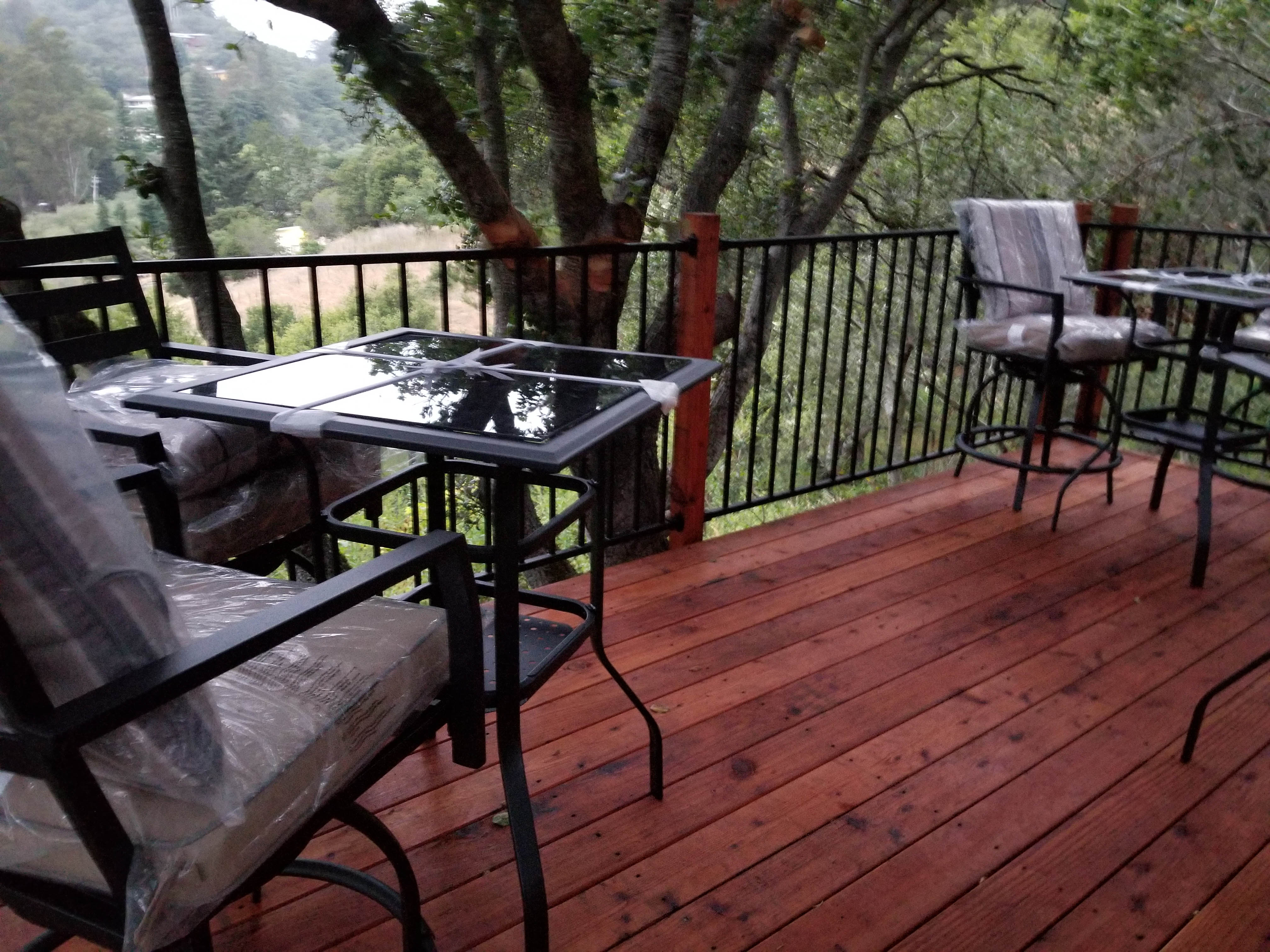
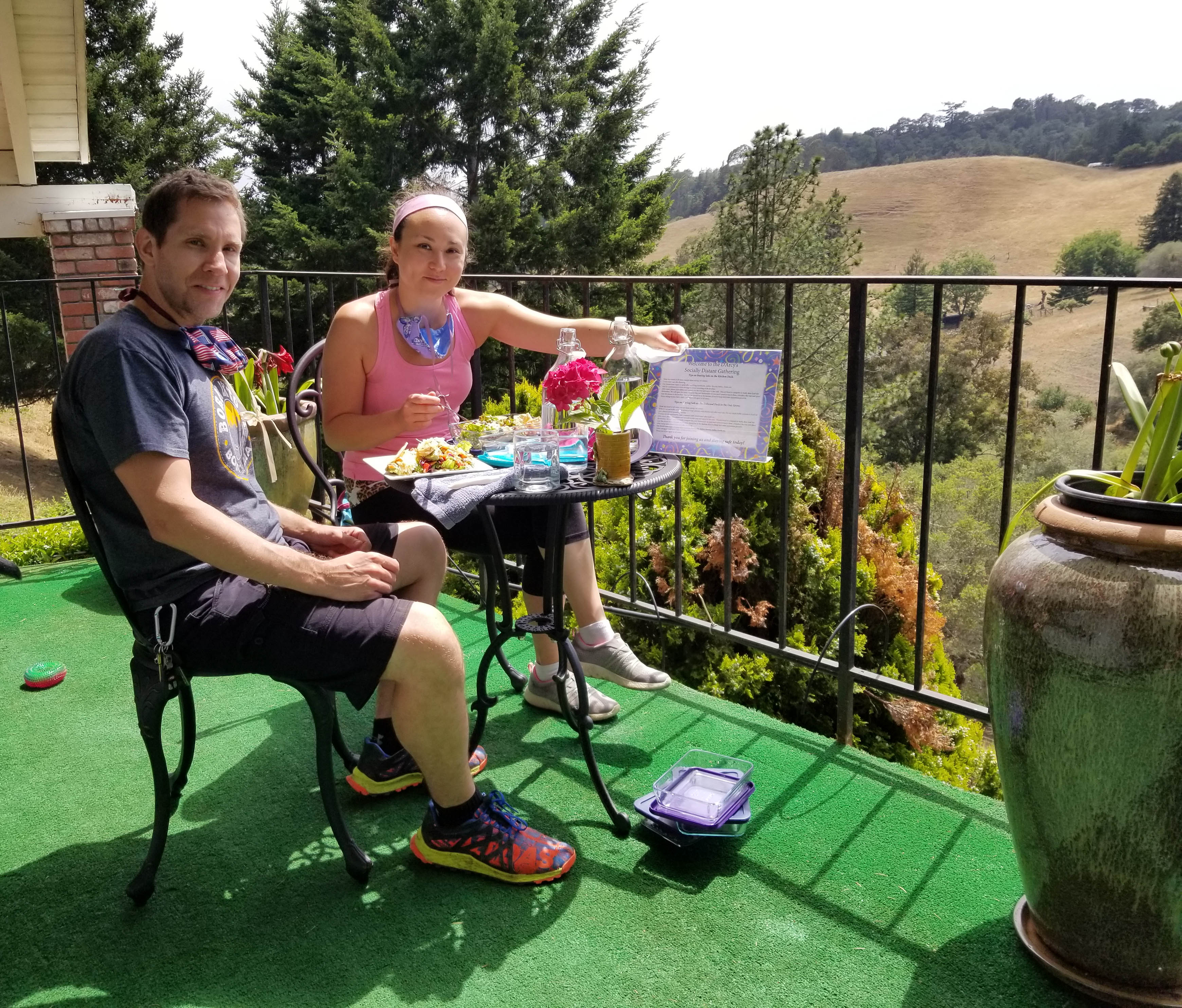
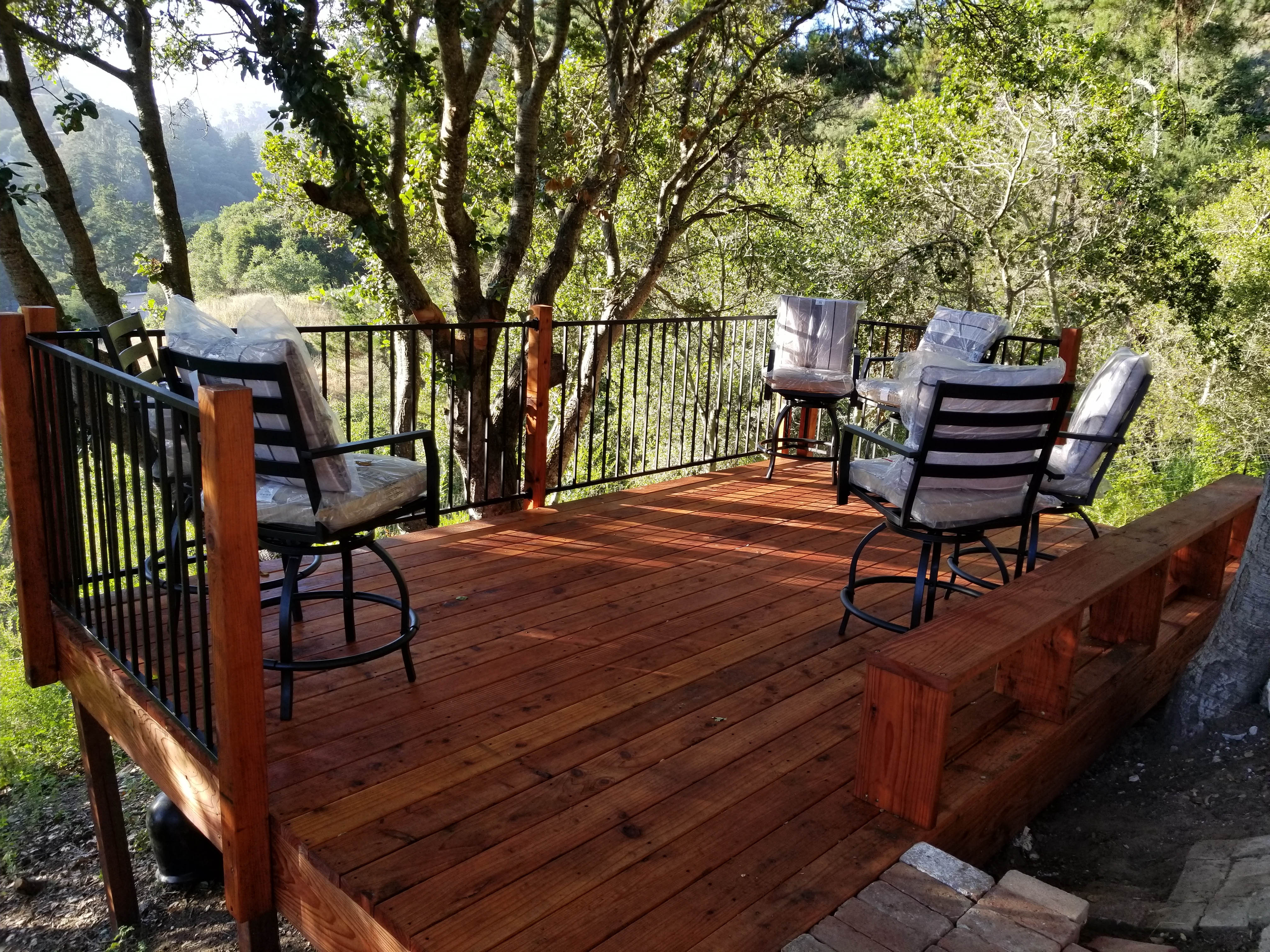
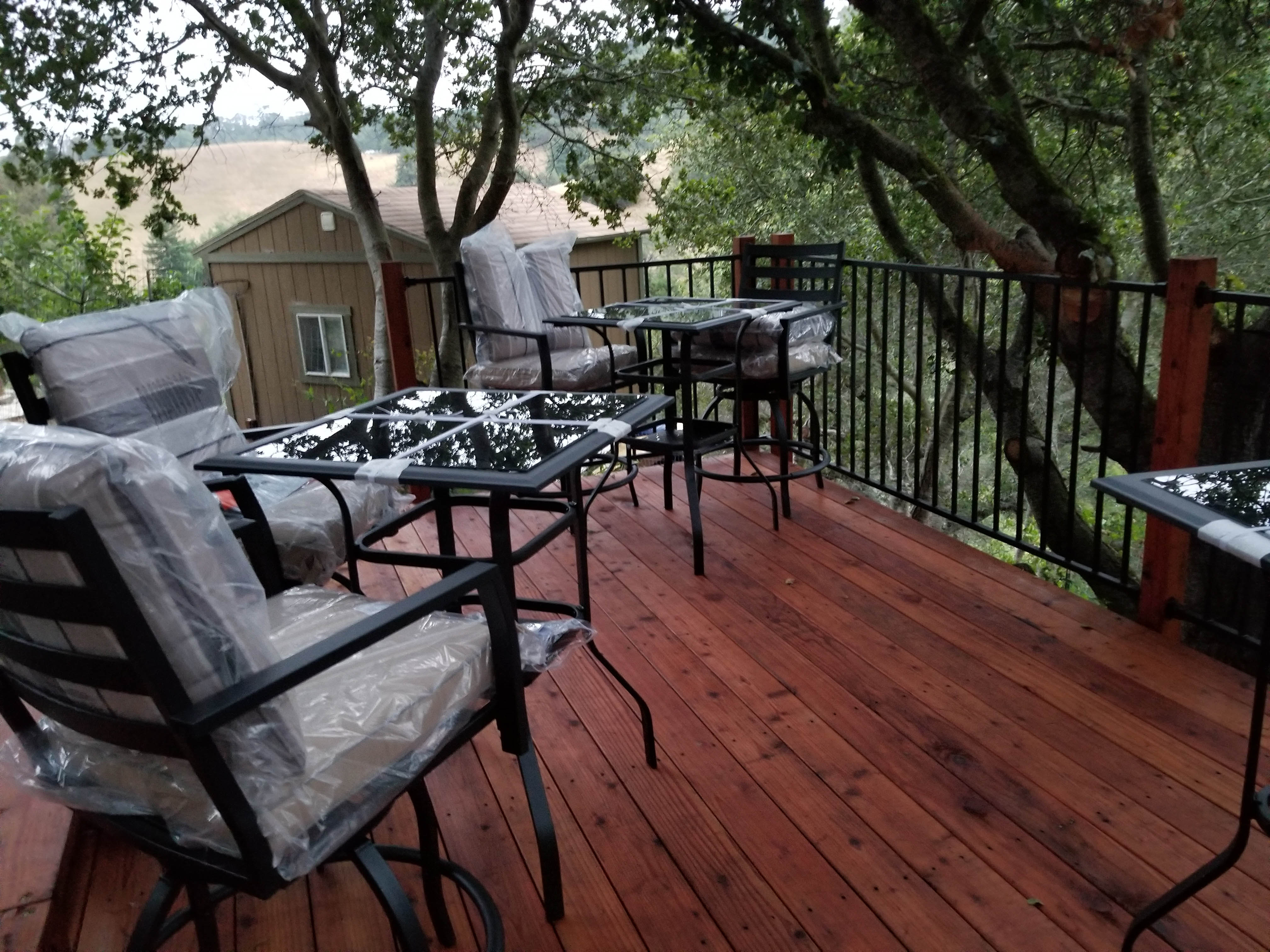
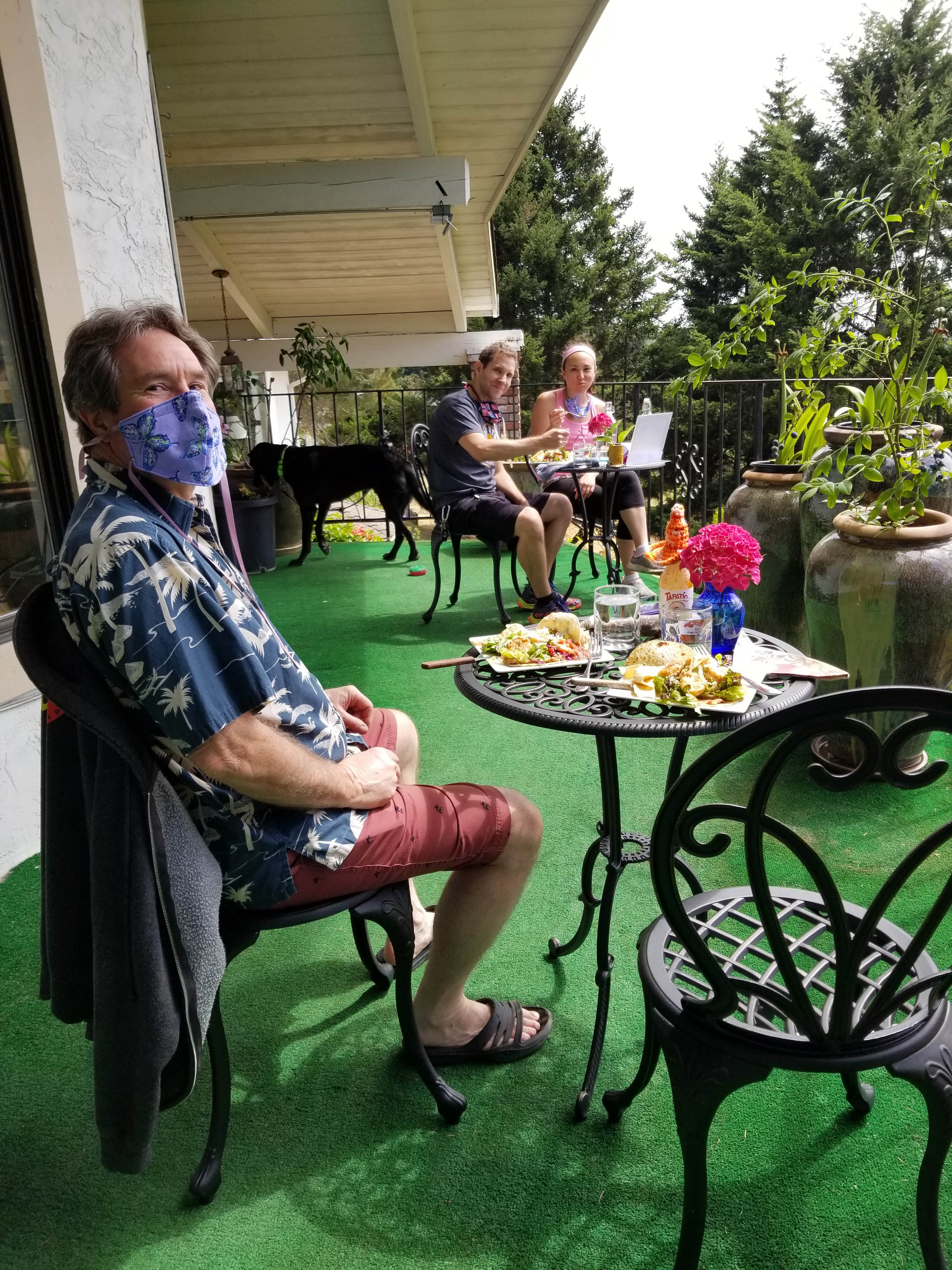
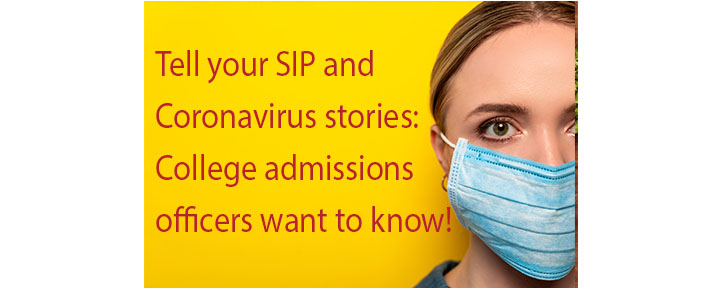
This is clearly the most unconventional and obstructive high school semester in our history since WWII. Everyone has been affected by school closures, shelter-in-place (SIP) orders, unemployment, and/or COVID-19. You all have your stories and the college admissions departments want to hear them. Schools will submit information about changes in class instruction, final exams, and grades or pass/fail as a result of SIP. Now students will have their opportunity to share their experiences on the college applications.
The Coalition for College Application has added a question to its application about how the coronavirus pandemic has affected their education. It will also have optional checkbox-style questions that describe how COVID-19 impacted their ability to do schoolwork, parents’ unemployment or employment as an essential worker, and family/friends who have gotten sick or died.
The Common Application has also added an optional question about students’ COVID-19 experiences. Here is the prompt:
“Community disruptions such as COVID-19 and natural disasters can have deep and long-lasting impacts. If you need it, this space is yours to describe those impacts. Colleges care about the effects on your health and well-being, safety, family circumstances, future plans, and education, including access to reliable technology and quiet study spaces. Do you wish to share anything on this topic? Y/N Please use this space to describe how these events have impacted you.”
This is a good time for high school seniors to reflect on how SIP and the coronavirus pandemic has changed their perspective on life. This essay will help college admissions officers learn more about them. Need help getting started? Click here for a free session.
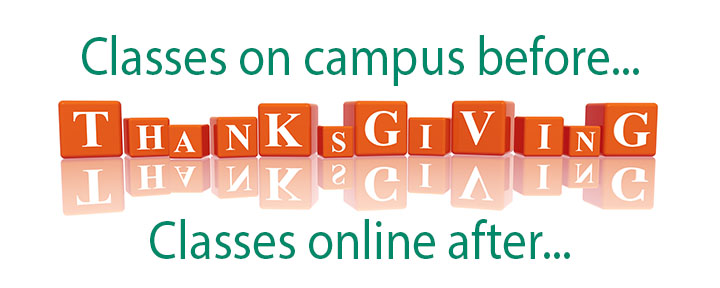
Colleges are struggling to make decisions on whether or not they’re going to have fall term on campus or online. Seems that about 30% of the incoming freshmen are waiting to make decisions about which colleges to attend based on whether or not they’ll start college on campus. Many parents are leery of spending over $60,000 for an online college experience for their kids.
On the other hand, colleges, like businesses, have been hit hard by shelter-in-place orders, and they need student tuition to stay afloat. While they want to protect their faculty and students from the coronavirus, they know students (and parents) don’t want to pay full tuition for online classes. That’s why several colleges are planning on a half-and-half solution.
With this new proposal, colleges will open for fall semester/quarter on campus. This gives students the opportunity to get out of the house and back on campus where they can have fun and get the full college experience. Parents will pay tuition, room and board, and travel expenses just as they had expected. Colleges reap the financial security they need for this term.
There will be no fall break (like spring break) in October for colleges that normally have them. Colleges worry that students will be exposed to the coronavirus at home and then spread it around campus when they return. Each college will set up social distancing protocol to meet their local requirements.
Then, the Friday before Thanksgiving, the students pack up their dorm rooms and head back home for the rest of the semester/quarter. That way they enjoy the holiday with family and friends, and then their courses all transfer to online sessions. The benefit here is that they’ll have already completed midterms and have a good grasp of each class’s protocol so switching to online classes should be seamless.
Colleges fear that the second wave of the coronavirus will wreak havoc on campus and it will be best for students to be safely at home after Thanksgiving and through winter break. Nobody is speculating about what may happen for winter or spring terms yet. Uncertainty seems to be the only constant here.
This is the buzz I’ve heard about a new fall term scenario on college campuses. It offers something for the students/professors and the college bursars. There are many options and colleges will be making announcements about fall term in the next few months.
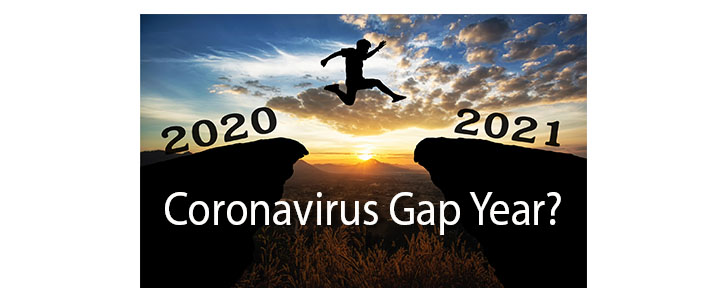
Students born in 2002 are facing TWO WHAMMIES this year. First, they’re graduating high school without the pomp and circumstance that every senior class since WWII has celebrated. You know the senior prom, graduation day, and grad parties. Second, they may miss out on the freshman experience this fall. Colleges don’t know if they’ll open their campuses or if they’ll conduct online classes like they did this spring semester. So what’s a high school grad to do? GAP YEAR!
Taking a traditional gap year may be the only option that grads can take if they want to have some sort of control over their future. Many colleges offer gap years to allow students to postpone their start date by one or two semesters and start the following year without having to reapply.
By delaying their matriculation to college, they won’t be at the mercy of the college or university’s decision to offer online, on campus, or some sort of hybrid instruction this fall. It takes the uncertainty away and puts the student in the driver’s seat. Parents love this because they won’t have to pay tuition or room/board during this turbulent time.
Other gap year options include doing independent research or projects, taking community college classes or doing structured programs that the college/university offers. Unfortunately with the coronavirus, students won’t be spending time travelling abroad as they have in previous years. Taking any kind of gap year will require working with your college’s advisors to navigate the newly emerging programs that every college is frantically organizing.
Talk to your advisor at your college to discuss options that work for you. Taking a gap year can be a double win: You get to choose what you’ll do this year and you get to have your freshman experience next year — presuming we get the coronavirus under control by then.
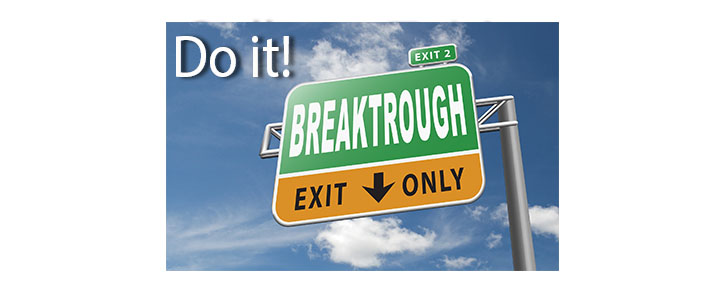
While we may feel like we were side swiped by the coronavirus and the disarray that the shelter-in-place order has caused us economically and socially, we should have known better. The signs were all there. Looking at the big picture, we have grown so big, so quickly, that we lost sight of what’s important.
Since the colonial times, America has been the pillar of innovation and entrepreneurship because it was founded by true pioneers. Our ancestors came to the United States to improve their lives; when they first arrived, they all faced discrimination, poverty, and uncertainty. It was those brave souls who came from the Europe, Asia, Africa, and South America who formed this incredible nation.
These wise and brave people built homes, started businesses, grew vegetables, and raised livestock. It’s their ingenuity that improved and increased production to make our lives better. The Industrial Revolution brought the cotton gin and the printing press. America was the leader in producing the biggest and the best, and we became a superpower. BUT, that was the beginning of the end.
Although we are grateful for the light bulb, the automobile, the airplane, and the refrigerator, we lost sight of the value of the well being of individual people. Businesses grew into large corporations with shareholders who demanded bigger profits with little regard for how their products might harm consumers or the earth. Just over the past 100 years, corporations have exploited marketplaces by choosing profits over the safety of the very people they sold their good to. Here is just the tip of the iceberg:
1. PLASTICS
Made from petroleum, plastic is in or used to package just about everything we buy. We produce so much plastic waste that landfills are closing and oceans are drowning in single-use plastics.
2. MEATS and DAIRY
Our livestock are pumped full of antibiotics and hormones to bump up sales and minimize labor. We now face antibiotic resistance, which will cause a horrifying pandemic when people die from illnesses that used to be cured by antibiotics.
3. VEGETABLES and FRUIT
Corporate farmers use pesticides that have known carcinogens. Companies like Bayer-Monsanto face major lawsuits against them for their Roundup weed killer that has caused cancer in thousands of people. They also grow GMO plants to produce larger vegetables by altering the genetic makeup of the plants.
4. ENERGY
We have viable energy solutions (solar, hydrogen, wind, geothermal, etc) ready to go but oil and gas companies control the auto and energy industries. They want to use up all of the oil (pumping for gasoline) and gas (fracking for methane) to make billions of dollars instead of using clean energy like solar, hydrogen, and others. They are the major contributors to the Climate Crisis.
We have become complacent over the past 70 years. Life was good but we weren’t watching the captain steer the ship. We got lazy, we got fat, we got self absorbed. Maybe the coronavirus and the climate crisis coming to a head at the same time is exactly what we need to become the pioneers our forefathers once were.
Those of us who are strong, innovative, and entrepreneurs will once again overcome these obstacles and reinvent the way we live. Our students and college graduates have an opportunity to force change and unite together. I hope that they will find solutions that respect human rights and the earth. It’s time to help our neighbors, produce healthy foods, use less energy, and heal our bodies.

History repeats itself. Plagues have wiped out millions of people every 100 years for 4 centuries. That’s why we trust facts and statistics. When we aren’t testing our 350 million US citizens, yet the government is talking about lifting the shelter-in-place orders based on economics and not the status of COVID-19, I am outraged and disillusioned.
My daughter Nicole (ER doc) just texted this to me:
“If the first wave of the Spanish Flu killed 3-5 million but the second wave killed 20-50 million, how are we going to handle the second wave?”
I told her that she shouldn’t be a hero when protestors are heading back to work, taking mass transportation, and ignoring the shelter-in-place orders. My friends and I have made 300 3-layered cloth masks with MERV-14 filters and 300 face shields to give every frontline worker in the Emergency Dept at her hospital the personal protection they can use when the second wave hits the Bay Area.
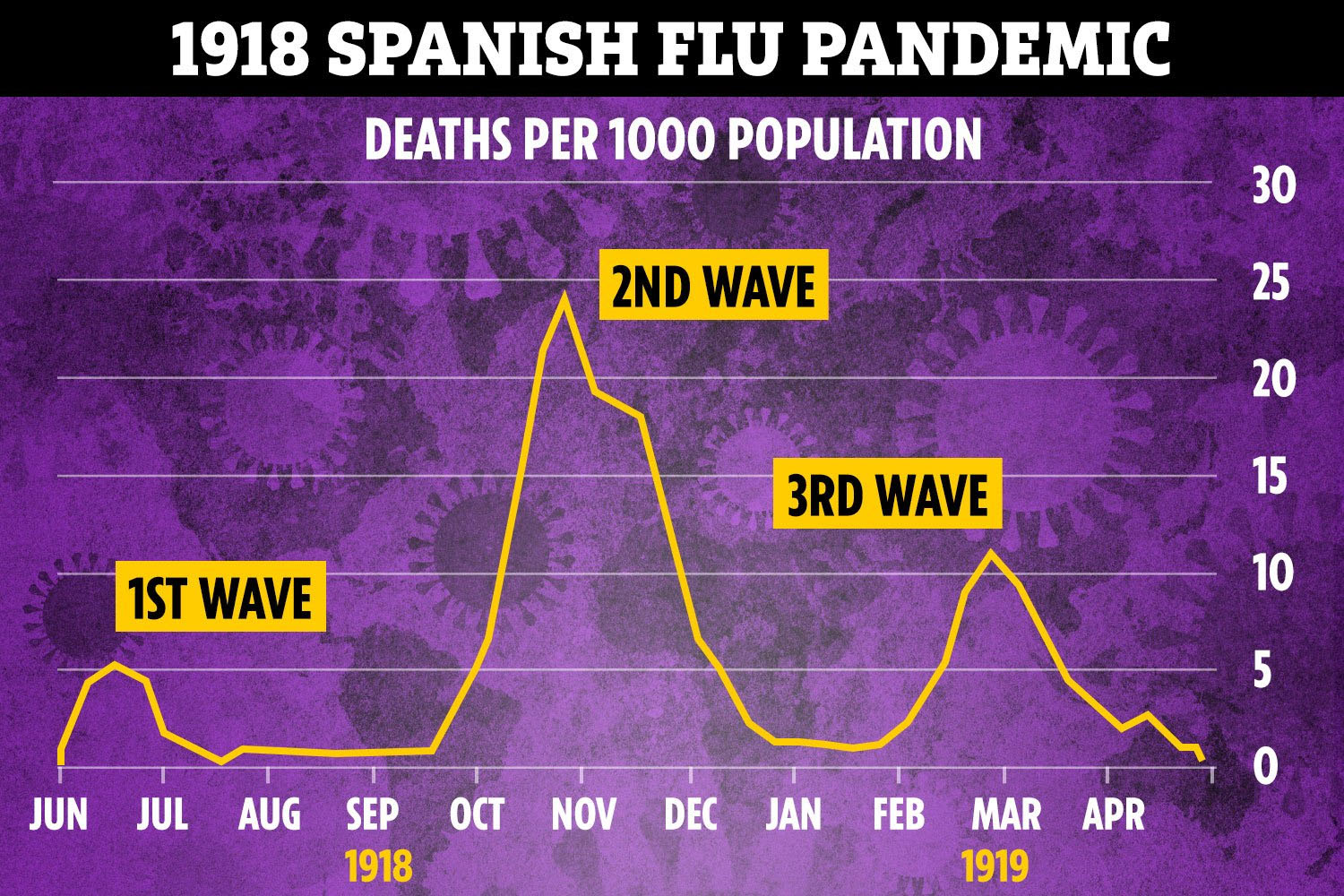 It sickens me to know that come fall 2020, my daughter and all of the healthcare workers in the United States and the world will face the second wave of this pandemic that will overwhelm them and probably kill 20-50 million people.
It sickens me to know that come fall 2020, my daughter and all of the healthcare workers in the United States and the world will face the second wave of this pandemic that will overwhelm them and probably kill 20-50 million people.
Why?
Because short-sighted people who run the government at the federal level and in many states don’t understand that by lifting the shelter-in-place order to get people back to work again BEFORE we’ve analyzed the spread of the virus and antibodies, we may experience an overwhelming resurgence of the coronavirus that will topple our economy and kill over 100 times more people in the process.
We need to listen to the medical professionals and stop listening to the politicians. Hunker down, simplify your life, and then come out to play and work when the coronavirus is contained and controlled.
